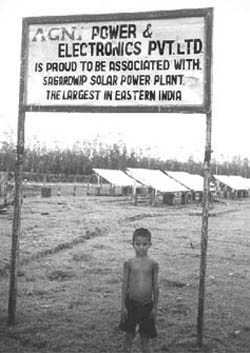A ray of solar hope
 when darkness approaches Sagar Island in the Sunderban delta of West Bengal, life no longer comes to a standstill. A silent revolution is slowly taking place in this remote island. More than 1000 houses are today electrified by solar energy through distribution lines, and more such projects are in the pipeline.
when darkness approaches Sagar Island in the Sunderban delta of West Bengal, life no longer comes to a standstill. A silent revolution is slowly taking place in this remote island. More than 1000 houses are today electrified by solar energy through distribution lines, and more such projects are in the pipeline.
Rich in mangrove swamps, waterways and small rivers, Sagar Island is also home to the endangered Royal Bengal Tiger. This unique island is one of the largest islands of the Sunderbans with a total area of around 300 sq kms, and a population of more than 1.5 lakhs spread over 16 villages. It is located approximately 90 kms south of Kolkata and separated from the main land by the river Muri Ganga, which is half an hour's ride by ferry.
Due to its remote location the island has no connection to the grid power since it would require an enormous amount for the infrastructure. "It is economically and technologically not viable,' says S P Gon Chaudhari, director, West Bengal Renewable Energy Development Agency ( wbreda ). Due to this problem, the best option is non-conventional energy.
Till recently, around 650 households were dependent on diesel generators supplied by the West Bengal State Electricity Board ( wbseb ). But due to huge losses there are no plans to expand its services. In some villages, private operators run diesel generators and supply electricity for a few hours charging a huge amount. But the situation is gradually changing and a number of solar power plants have come up since the inception of the wbreda in 1993.
The first power plant set up in 1995-1996 is still in operation: many spv s have been added since then. Currently, there are eight solar photovoltaic ( spv ) power plants of around 25 and 26 kw in the entire island. Each plant supplies power to approximately 130 households within a periphery of 1.5 kms. The entire connection is carried out impressively through underground cabling.
The ministry of non-conventional energy source, Indian Renewable Energy Development Agency and the state government bears the cost of establishing these plants by contributing 50, 40 and 10 per cent respectively. The cost of the plants ranges from Rs 85 lakh to Rs 2.7 crore.
With the support of wbreda , the local community carried out the entire operation efficiently. "Since the communities are the beneficiaries they will take extra care not to get the plant damaged,' says Choudhari. The local panchayat selects the location for the power plant and the local co-operative
Related Content
- Renewables are a better investment than carbon capture for tackling climate change
- Energy and oil majors turn to rural Africa in grab for world’s next billion customers
- Female Solar Engineers Bring Hope To Farmers In Togo
- Palestinians turn to the sun to reduce their power shortfall
- India may install 225 GW renewable power by 2022: Power Minister
- Solar microgrids light up remote Jharkhand villages
